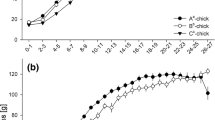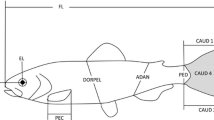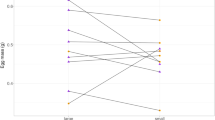Abstract
In most egg-laying vertebrates, maternal responses to stressful conditions are translated into the release of glucocorticoid hormones such as cortisol, which are then transmitted to their developing embryos. Although such maternally transmitted hormonal resources have been shown to influence or even interfere with the optimal developmental trajectories of offspring in many taxa, their influence on the dynamics of wild fish populations remains largely unexplored. Here, we examined the extent to which simulated hormonally mediated maternal effects influence the development and early survival of the coral reef damselfish, Pomacentrus amboinensis. Concentrations of cortisol in the eggs were manipulated within naturally occurring limits by immersion. We found that the proportion of embryos that delayed hatching when exposed to high levels of cortisol was considerably lower than in the other two treatments (low cortisol dose and control). High cortisol levels in P. amboinensis eggs resulted in increased egg mortality and greater asymmetry in hatchlings. For embryos that successfully hatched, individuals from the elevated cortisol treatments (especially low dose) survived longer after hatching. Although individuals that originated from eggs with elevated cortisol levels survived longer after hatching, they may not gain an overall survival advantage. Our results suggest that subtle increases in the allocation of maternally derived hormones, such as cortisol, to offspring are a direct way for stressed mothers to endow their young with an immediate survival advantage. We propose that this immediate benefit outweighs the developmental costs which may be expressed as reduced fitness at later life stages.






Similar content being viewed by others
References
Barry TP, Malison JA, Held JA, Parrish JJ (1995) Ontogeny of the cortisol stress response in larval rainbow trout. Gen Comp Endocrinol 97:57–65
Braastad BO (1998) Effects of prenatal stress on behaviour of offspring of laboratory and farmed mammals. Appl Anim Behav Sci 61:159–180
Bowden RM, Ewert MA, Nelson CE (2002) Hormone levels in yolk decline throughout development in the red-eared slider turtle (Trachemys scripta elegans). Gen Comp Endocrinol 129:171–177
Crespi EJ, Denver RJ (2005) Ancient origins of human developmental plasticity. Am J Hum Biol 17:44–54
de Fraipont M, Clobert J, John-Alder H, Meylan S (2000) Increased prenatal maternal corticosterone promotes philanthropy of offspring in common lizard (Lacerta vivipara). J Anim Ecol 69:404–413
De Jesus EG, Hirano T (1992) Changes in whole body concentrations of cortisol, thyroid hormones and sex steroids during early development of the chum salmon, Oncorhynchus keta. Gen Comp Endocrinol 85:55–61
Debat V, David P (2001) Mapping phenotypes: canalization, plasticity and developmental stability. Trends Ecol Evol 16:555–561
Denver RJ (1997) Environmental stress as a developmental cue: corticotrophin-releasing hormone is a proximate mediator of adaptive phenotypic plasticity in amphibian metamorphosis. Horm Behav 31:169–179
Dillon TM, Lynch MP (1981) Physiological responses as determinants of stress in marine and estuarine organisms. In: Barrett GW, Rosenberg R (eds) Stress effects on natural ecosystems. Wiley, New York, pp 227–241
Dufty AM Jr, Clobert J, Møller AP (2002) Hormones, developmental plasticity and adaptation. Trends Ecol Evol 17:190–196
Eising CM, Muller W, Dijkstra C, Groothuis TGG (2003) Maternal androgens in egg yolks: relation with sex, incubation time and embryonic growth. Gen Comp Endocrinol 132:241–247
Elf PK, Fivizzani AJ (2002) Changes in sex steroid levels in yolks of the leghorn chicken, Gallus domesticus, during embryonic development. J Exp Zool 293:594–600
Elf PK, Lang JW, Fivizzani AJ (2002) Dynamics of yolk steroid hormones during development in a reptile with temperature-dependent sex determination. Gen Comp Endocrinol 127:34–39
Emslie MJ, Jones GP (2001) Patterns of embryo mortality in a demersally spawning coral reef fish and the role of predatory fishes. Environ Biol Fish 60:363–373
Eriksen MS, Haug A, Torjesen PA, Bakken M (2003) Prenatal exposure to corticosterone impairs embryonic development and increases fluctuating asymmetry in chickens (Gallus domesticus). Br Poult Sci 44:690–697
Eriksen MS, Bakken M, Espmark Å, Braadstad BO, Salte R (2006) Prespawning stress in farmed Atlantic salmon Salmo salar: maternal cortisol exposure and hyperthermia during embryonic development affect offspring survival, growth and incidence of malformations. J Fish Biol 69:114–129
Gagliano M, McCormick MI (2007) Maternal condition influences phenotypic selection on offspring. J Anim Ecol 76:174–182
Gagliano M, Depczynski M, Simpson SD, Moore JAY (2008) Dispersal without errors: symmetrical ears tune into the right frequency for survival. Proc R Soc B 275:527–534
Gibson G, Wagner G (2000) Canalization in evolutionary genetics: a stabilizing theory? Bioessays 22:372–380
Groothuis TGG, Müller W, von Engelhardt N, Carere C, Eising C (2005) Maternal hormones as a tool to adjust offspring phenotype in avian species. Neurosci Biobehav Rev 29:329–352
Hayward LS, Wingfield JC (2004) Maternal corticosterone is transferred to avian yolk and may alter offspring growth and adult phenotype. Gen Comp Endocrinol 135:365–371
Kerrigan BA (1996) Temporal patterns in the size and condition of settlement in two tropical reef fishes (Pomacentridae: Pomacentrus amboinensis and P. nagasakiensis). Mar Ecol Prog Ser 135:27–41
Kitaysky AS, Kitaiskaia EV, Piatt JF, Wingfield JC (2003) Benefits and costs of increased levels of corticosterone in seabird chicks. Horm Behav 43:140–149
Lacey EP (1998) What is an adaptive environmentally induced parental effect? In: Mousseau TA, Fox CW (eds) Maternal effects as adaptations. Oxford University Press, New York, pp 54–66
Leis JM, McCormick MI (2002) The biology, behavior and ecology of the pelagic, larval stage of coral reef fishes. In Sale PF (ed) Coral reef fishes—dynamics and diversity in a complex ecosystem. Academic Press, London, pp 171—199
Lemberget T, McCormick MI (2009) Replenishment success linked to fluctuating asymmetry in larval fish. Oecologia 159:8–93
Lychakov DV, Rebane YT, Lombarte A, Fuiman LA, Takabayashi A (2006) Fish otolith asymmetry: morphometry and modeling. Hear Res 219:1–11
McCormick MI (1998) Behaviourally induced maternal stress in a fish influences progeny quality by a hormonal mechanism. Ecology 79:1873–1883
McCormick MI (1999) Experimental test of the effect of maternal hormones on larval quality of a coral reef fish. Oecologia 118:412–422
McCormick MI (2006) Mothers matter: crowding leads to stressed mothers and smaller offspring in marine fish. Ecology 87:1104–1109
McCormick MI (in press) Indirect effects of heterospecific interactions on progeny quality through maternal stress. Oecologia doi:10.1111/j.1600-0706.2008.17410.x
McCormick Mi, Gagliano M (in press) Carry-over effects: the importance of a good start. Eleventh International Coral Reef Symposium
McCormick MI, Nechaev I (2002) Influence of cortisol on developmental rhythms during embryogenesis in a tropical damselfish. J Exp Zool 293:456–466
McCormick MI, Smith SA (2004) Efficacy of passive integrated transponder tags to determine spawning site visitations by a tropical fish. Coral Reefs 23:570–577
Møller AP, Swaddle JP (1997) Asymmetry, developmental stability and evolution. Oxford University Press, Oxford
Palmer AR, Strobeck C (1986) Fluctuating asymmetry: measurement, analysis, patterns. Annu Rev Ecol Syst 17:391–421
Palmer AR, Strobeck C (2003) Fluctuating asymmetry analyses revisited. In: Polak M (ed) Developmental instability (DI): causes and consequences. Oxford University Press, Oxford, pp 279–319
Räsänen K, Kruuk EB (2007) Maternal effects and evolution at ecological time-scales. Funct Ecol 21:408–421
Rombough PJ (1994) Energy partitioning during fish development: additive or compensatory allocation of energy to support growth? Funct Ecol 8:178–186
Santos M, Iriarte PF, Cespedes W (2005) Genetics and geometry of canalization and developmental stability in Drosophila subobscura. Evol Biol 5:7–7
Sokal RR, Rohlf FJ (2001) Biometry. Freeman, New York
Szisch V, Papandroulakis N, Fanouraki E, Pavlidis M (2005) Ontogeny of the thyroid hormones and cortisol in the gilthead sea bream, Sparus aurata. Gen Comp Endocrinol 142:186–192
Weiss SL, Johnston G, Moore MC (2007) Corticosterone stimulates hatching of late-term tree lizard embryos. Comp Biochem Physiol A Mol Integr Physiol 146:360–365
Welberg LAM, Seckl JR (2001) Prenatal stress, glucocorticoids and the programming of the brain. J Neuroendocrinol 13:113–128
Acknowledgments
We thank U. Siebeck for assistance in the field, M. Depczynski and J. A. Y. Moore for comments on an earlier version of the manuscript. This research was supported by the ARC Centre of Excellence for Coral Reef Studies (to M. I. McCormick), a JCU Doctoral Scholarship and a Nancy Vernon Rankine grant (to M. Gagliano), and is also an output of the AIMS@JCU joint venture. The experiments in this study comply with the current laws of Australia and were conducted under permits from the Great Barrier Reef Marine Park Authority and the JCU Animal Ethics Committee.
Author information
Authors and Affiliations
Corresponding author
Additional information
Communicated by Joel Trexler.
Electronic supplementary material
Below is the link to the electronic supplementary material.
Rights and permissions
About this article
Cite this article
Gagliano, M., McCormick, M.I. Hormonally mediated maternal effects shape offspring survival potential in stressful environments. Oecologia 160, 657–665 (2009). https://doi.org/10.1007/s00442-009-1335-8
Received:
Accepted:
Published:
Issue Date:
DOI: https://doi.org/10.1007/s00442-009-1335-8




